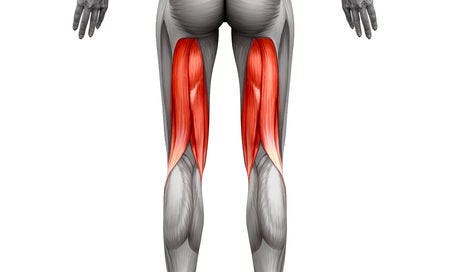In the second edition of Muscle Monday, we look at a muscle group higher up in the leg: The hamstrings. If you haven’t already looked at last week’s newsletter about the calf muscles, you can access that piece below. As always, please share and subscribe for free if you enjoy my work.
Muscles of the hamstrings
The hamstring muscle group is located at the back of the thigh, as highlighted in the picture above. Just like the calf muscles last week, there are 3 muscles which belong in the hamstring group. They are as follows:
The semimembranosus is a deep and medial (inside of the leg) muscle.
The semitendinosus is lateral (further to the outside of the leg) compared to the semimembranosus, but is not as lateral as the Biceps femoris. It is the longest of the three muscles.
The Biceps femoris is the most lateral muscle in the group. The ‘Bi-ceps’ part of the name refers to the fact that the muscle has two heads: One long head, and one short head.
Function of the hamstring muscles
As a group of muscles, the hamstrings are generally responsible for knee flexion (bending the knee). However, the muscles have specific individual roles.
The semimembranosus
Whilst being strongly involved with knee flexion, it also helps with actions to extend the hip, such as moving the leg behind the body to increase the angle of the hip. It also helps with internal rotation of the tibia bone in the shin, which describes the movement which occurs when the toes point inwards and the heel points outwards.
The semitendinosus
Whilst having a very similar role to the semimembranosus, the semitendinosus has a unique feature. It is able to assist another muscle in the back of the knee, called the popliteus. These muscles work together to enable internal tibial rotation.
Biceps femoris
The two heads of the biceps femoris have slightly different roles. The long head is responsible for knee flexion and hip extension as previously outlined. It also can assist with lateral tibia rotation and lateral thigh rotation, depending on the position of the knee and hip.
The short head also flexes the knee, and can laterally rotate the tibia, too, depending on whether the knee is flexed slightly.
Unique conditions (Besides strains and tears)
Unfortunately, the most common injuries and issues with the hamstring group tend to be muscle and tendon strains. They are, however, immediately obvious, as most people tend to immediately reach for the back of their thigh at the moment of injury. In extreme cases, a hamstring muscle tear has been described as feeling as if being shot in the back of the leg.
Athletes or individuals who sprint a lot, or require lots of power, are more susceptible to hamstring injuries. Footballers can be particularly prone, due to their over-familiarisation with a kicking action, which strengthens the opposite muscles at the front of the thigh and could lead to imbalances without correct training.
The hamstrings are one of the most common sites for muscle cramps or spasms, along with the calves.
Strengthening the hamstring muscles
The hamstrings make up a portion of the posterior chain, which is the sequence of muscles in the back of the body, from the upper back all the way down to the calves. As a result, exercises which train this posterior chain may engage the hamstrings. They are also very much used in hinge or hip-dominant movements. The following exercises are commonly used to strengthen the hamstrings.
Deadlifts or Romanian Deadlifts (RDLs)
Most deadlift variants are perfect for training the hamstrings. They require an element of hip hinge under tension and can be performed with a barbell, trap bar, kettlebells, or dumbbells. The only key is thinking about sending your hips to the back of the room, as opposed the sitting down into a squatting movement.
Hamstring bridges
The classic bridge exercise can be shifted to more hamstring dominance easily enough. Adopt the standard bridge position, then straighten the legs slightly, take the toes off the floor and point them towards the ceiling. Performing the bridge from this start position should engage the hamstrings more.
Swiss ball hamstring curls
A level up from the hamstring bridge. Place a Swiss ball under your feet and then adopt the hamstring bridge position. Whilst the hips are off the floor, use your feet to roll the ball towards your bottom, and then straighten your legs to roll it back to the starting position.
A quick, but insightful review of the muscles at the back of the thigh. If you found this interesting, please share far and wide. If you’re still reading, please also answer the following poll - it may be useful in a few weeks!






Hi Ben, I've just discovered your posts and think they are great! Very informative and succinct. I'm enjoying reading about the mechanics of the body.
This particular post is quite helpful as I have been dealing with a hamstring issue for some time (unfortunately not long after getting over my quad issue!).
Perhaps the next post could be glutes focused?
Currently going through your others posts so thank you in advance!
Interesting little article. It would be interesting to have a follow-up with the best ways to rehab (and prevent) hamstring strains).